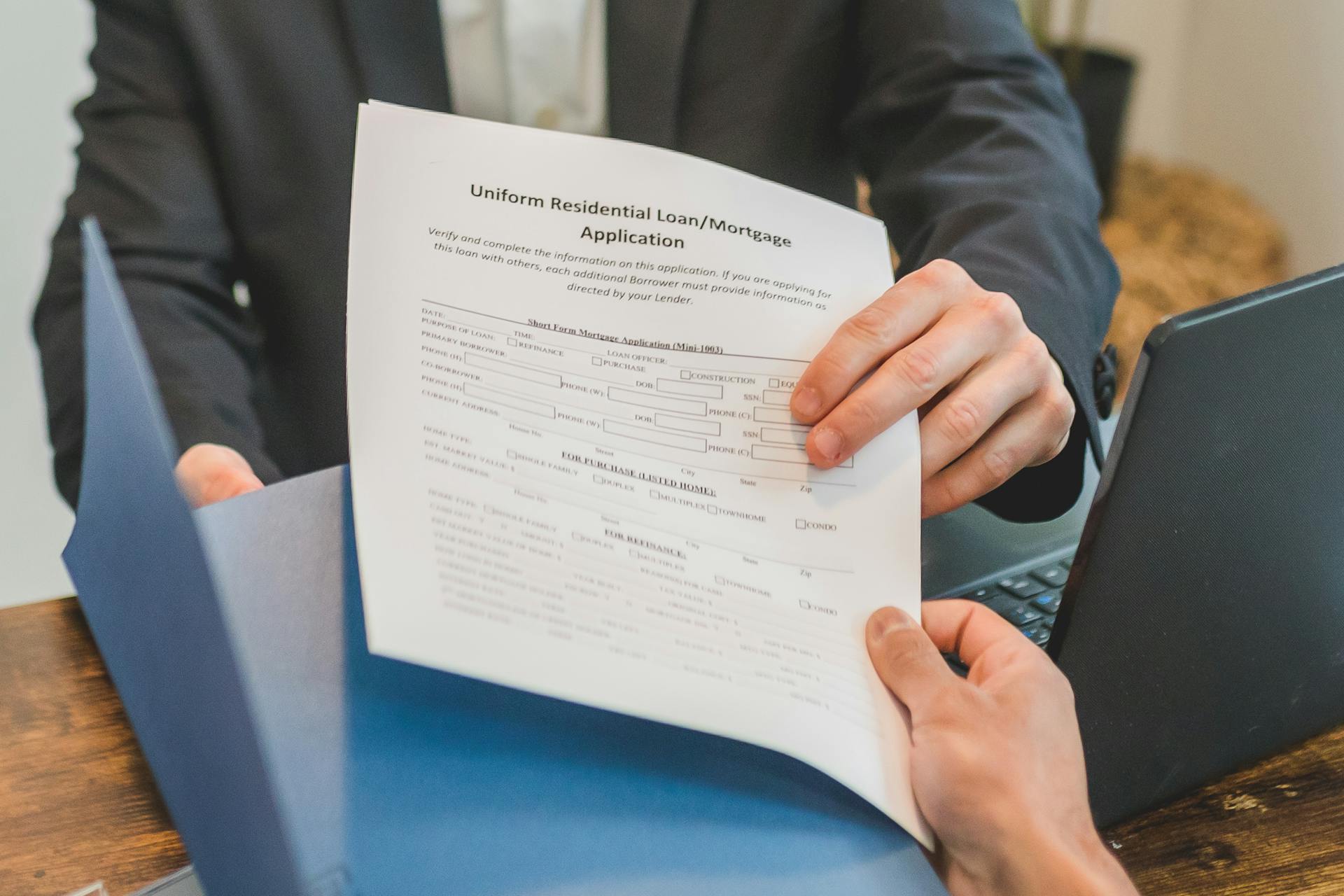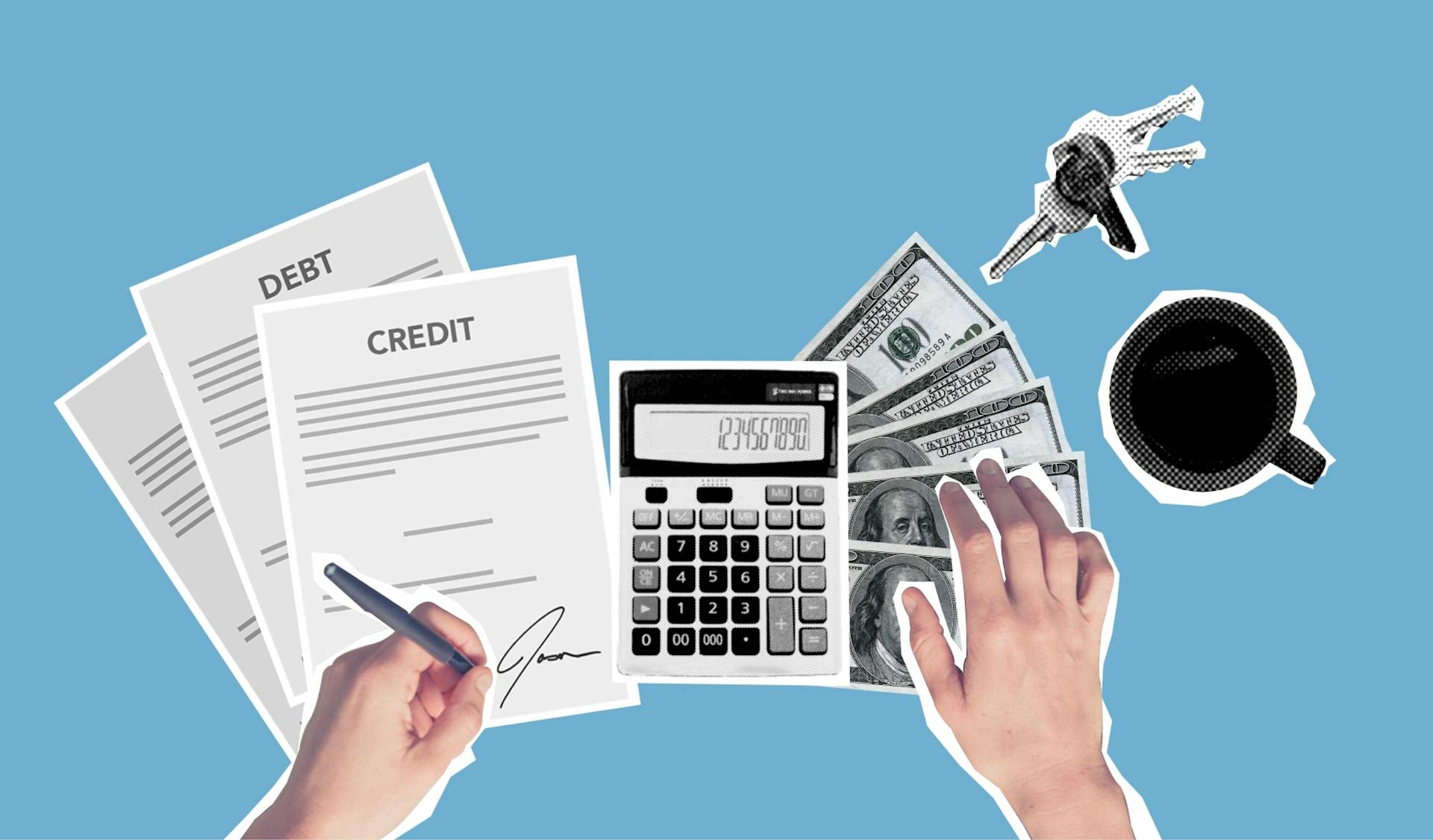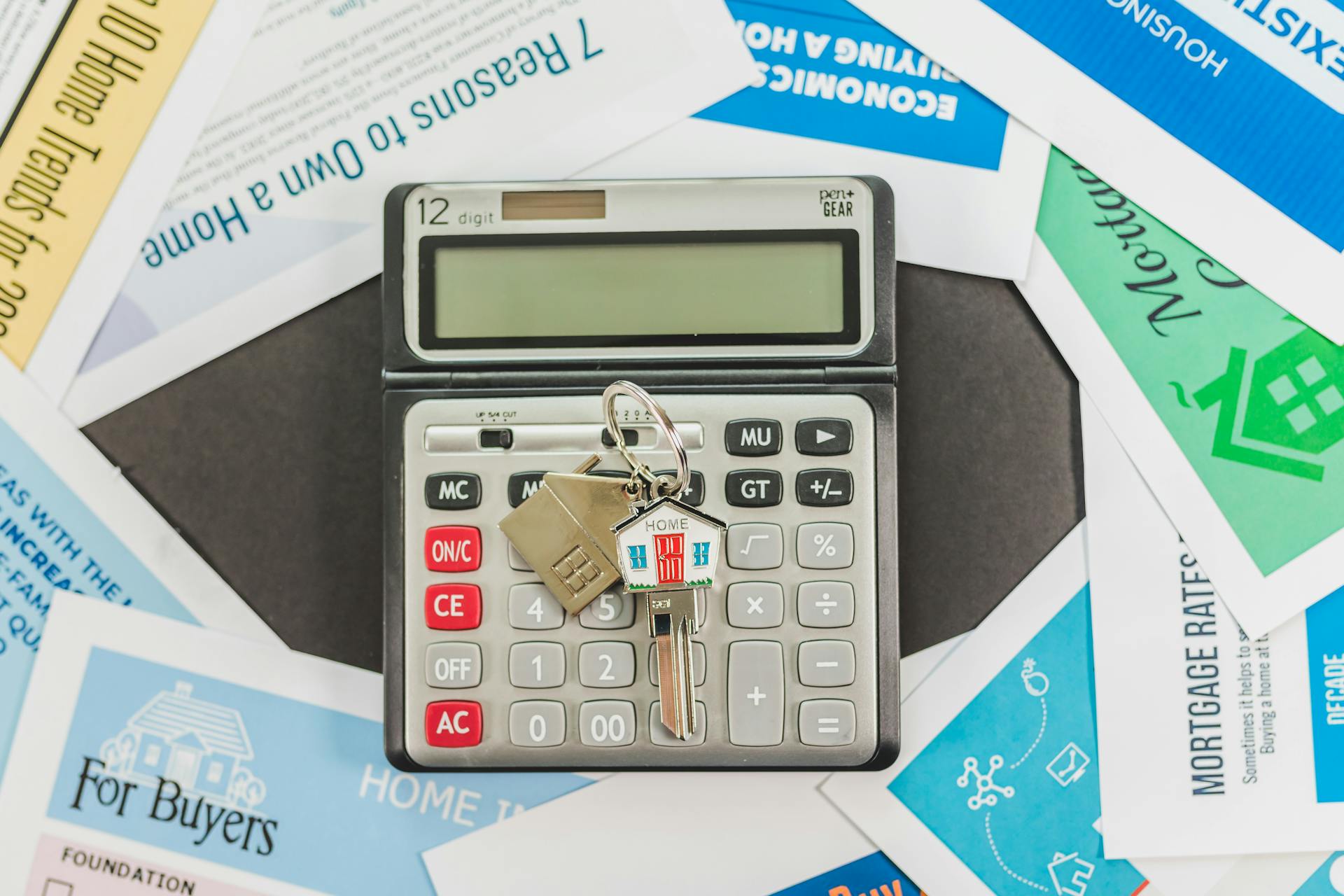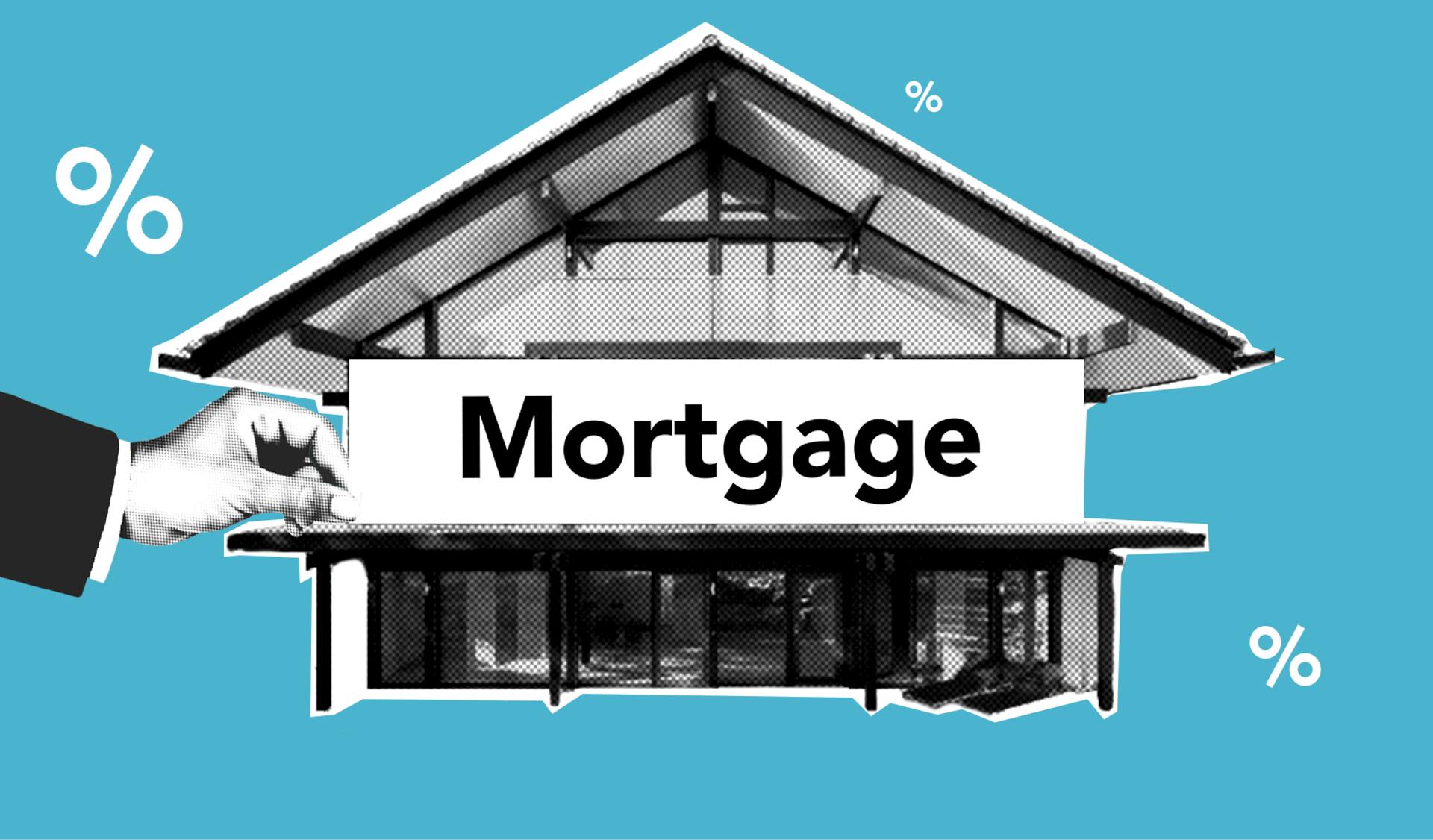
Refinanced loan options can be a lifesaver for homeowners looking to lower their monthly payments or tap into their home's equity. You can refinance your loan with a new lender, or work with your current lender to get a better deal.
To qualify for a refinanced loan, you'll typically need to have a good credit score, a stable income, and a low debt-to-income ratio. This is because lenders want to ensure you can afford the new loan payments.
A refinanced loan can come in the form of a fixed-rate loan, an adjustable-rate loan, or a government-backed loan, such as an FHA or VA loan. These options often have more lenient credit score requirements and lower down payment options.
You can refinance your loan with a short-term loan, such as a 15-year loan, or a long-term loan, such as a 30-year loan. Short-term loans often have lower interest rates, but higher monthly payments.
Check this out: Payday Lender Services
Refinancing Basics

Refinancing a loan can be a complex process, but understanding the basics is essential to making an informed decision.
Refinancing typically involves replacing an existing loan with a new one, often with a lower interest rate or better terms.
A refinanced loan can help you save money on interest over the life of the loan, with some homeowners saving up to $200 per month.
The process of refinancing usually takes 30 to 60 days, depending on the lender and the complexity of the loan.
Readers also liked: Streamline Refi
What's the Cost of Refinancing?
Refinancing can save you money, but it's essential to consider the costs involved. You may be able to get a lower interest rate, which can lead to lower monthly payments.
The cost of refinancing varies from state to state and lender to lender. You can expect to pay 3 percent to 6 percent of your outstanding principal in refinancing fees. This includes expenses like application fees, loan origination fees, points, and survey fees.
For another approach, see: Housing Loan Fees

Some common fees associated with refinancing include an application fee, which can range from $75 to $300, and a loan origination fee, which can be 0% to 1.5% of the loan principal. You may also be charged points, which are equal to 1 percent of the amount of your mortgage loan.
Here are some typical fees and average cost ranges you may encounter when refinancing:
You may also be charged a prepayment penalty, which can range from one to six months' interest payments. It's essential to review your settlement cost papers (the HUD-1 form) one day in advance of your loan closing to verify the terms.
The APR (Annual Percentage Rate) is a measure of your total refinance loan costs, including interest and origination fees. Your mortgage interest rate is the percentage you'll pay as a fee for borrowing the money.
A fresh viewpoint: What Is Apy in Banking Terms
Homeowners Seeking PMI Elimination
If you're currently paying private mortgage insurance (PMI), your increased home equity and the principal you've paid down could qualify you to eliminate it.

Refinancing your mortgage might be a good option if you've built substantial equity through rising home values or consistent mortgage payments.
Even if you end up with a higher interest rate after a refi, removing PMI could still save you money in the long run.
Removing PMI can be a worthwhile investment if you've been paying PMI for a while and have a significant amount of equity in your home.
Notice About Federal Loans
If you have a federal student loan owned by the Department of Education, such as a Direct Loan or a FFELP loan, be aware that the federal government temporarily suspended your payments and waived your interest since March 13, 2020, due to the coronavirus epidemic.
Congress and/or the Department of Education may extend these benefits or offer other benefits in the future. You will lose your current federal benefits and your right to any future benefits if you refinance your federal student loans with a private student loan.
Interest rates on these loans resume September 1, 2023, and payments resume in October 2023. For more information, check the Federal government's website at https://studentaid.gov/announcements-events/coronavirus.
You can check with your loan servicer to see what kind of loan you have if you're unsure whether you qualify for these benefits.
A fresh viewpoint: Cash Advance Monthly Payments
When to Refinance

Refinancing your mortgage can be a great way to save money or achieve your financial goals, but it's essential to know when it makes sense.
Unless your current mortgage rate is near or above 8%, refinancing may not be the best option. However, there are some exceptions worth considering.
You may want to refinance if you need to switch to a longer loan term, such as from a 15-year mortgage to a 30-year mortgage, to give yourself some breathing room in your budget.
If you have high credit card balances and a lot of home equity, a cash-out refinance could help you pay off those high-interest rate balances.
For those with high credit card debt, a cash-out refinance can be a more cost-effective way to pay off your debt compared to using a credit card or personal loan to finance your fixer-upper projects.
You may also want to refinance if you want to get rid of mortgage insurance, which can be a significant monthly expense. To cancel your private mortgage insurance, you'll need at least 20% equity in your home.
Expand your knowledge: Do I Need Disability Income Insurance
Why We Chose

We chose Rate because it's a mortgage lender that specializes in a digital mortgage experience, founded in 2000 and formerly known as Guaranteed Rate.
Rate offers a wide variety of refinance programs, including seven different refinance options, making it a great choice for those looking to refinance their home.
One of the standout features of Rate is its easy online application process, which allows consumers to check out refinance rates online and find information about Rate's loan products.
Rate also offers a range of fixer-upper refinance programs, giving homeowners who need to make repairs to their property more options for refinancing.
Here's an interesting read: Cash Advance Options
Recent Buyers with Over 7% Secured
If you secured a mortgage rate above 7% in the last couple of years, doing a refinance now could lead to big savings in interest and your monthly payment.
According to Debbie Calixto, sales manager at loanDepot, this could mean hundreds of dollars in savings each month.

To put this into perspective, look for a rate at least 0.5% to 1% lower than your current rate. This reduction could significantly reduce your monthly payments and interest fees over the life of the loan.
Just be sure to review the closing costs carefully to ensure the savings outweigh the expense.
Here's a rough idea of what this could look like in terms of monthly savings:
Keep in mind that this is just an estimate, and your actual savings will depend on your individual situation.
Refinancing Process
Refinancing a loan can be a straightforward process. You'll need to check your credit score, which can affect the interest rate you'll qualify for, as mentioned in the "Credit Score" section. A good credit score can lead to a lower interest rate and more favorable terms.
To start the refinancing process, you'll need to gather your financial documents, including your income, expenses, and debt obligations, as outlined in the "Eligibility" section. This information will help you determine how much you can afford to borrow.
Once you've gathered your documents and checked your credit score, you can begin comparing rates and terms from different lenders, as discussed in the "Types of Refinanced Loans" section. This will help you find the best option for your needs.
Suggestion: British Terms for Money
Refinancing Calculators

Refinancing calculators can be a valuable tool in determining whether refinancing your mortgage makes sense for you. These online tools require information about your current mortgage and the new loan you're considering.
Some refinancing calculators ask for your tax rate and the interest rate you can get on investments, assuming you'll invest your savings. This information helps you determine how much you'll save compared to the costs you'll pay.
A refinancing calculator will show you the amount you'll save compared to the costs you'll pay, helping you decide if the refinancing offer is right for you. The National Bureau of Economic Research has an example of a refinancing calculator.
To use a refinancing calculator effectively, you'll need to provide information about your current mortgage and the new loan you're considering. This includes the remaining principal, interest rate, and years remaining on your mortgage, as well as the upfront or closing costs of the new loan.
Discover more: Home Equity Loan to Pay off Student Loans

Here's a step-by-step guide to calculating the break-even period:
Talk to Your Lender
You may want to start by talking to your current lender about refinancing, as they may be willing to reduce or eliminate some of the typical refinancing fees.
If your current mortgage is only a few years old, your lender may be more likely to offer you a good deal. This is because the paperwork relating to that loan is still current.
Your lender may not charge an application fee or origination fee if you decide to refinance with them. This can save you some money upfront.
Let your lender know that you're shopping around for the best deal, as this may motivate them to offer you a better refinancing option.
A unique perspective: Fixed Finance Charge
How to Get a Mortgage
To get a mortgage, you'll need to start by knowing your credit score. A 780 FICO Score is the limit for the best conventional mortgage rates.
Your credit score plays a huge role in determining the interest rate you'll qualify for. A good credit score can save you thousands of dollars in interest payments over the life of the loan.
To get a mortgage, you'll also need to estimate your home's value. You can try a home value estimator or contact your real estate agent to help. The more equity you have, the lower your rate will typically be.
Some mortgage programs don't require appraisals, which can be a big plus if you don't have much equity in your home. These programs include FHA streamline refinance and VA interest rate reduction refinance loan (IRRRL).
Here are some key factors to consider when getting a mortgage:
Refinancing Options
You can choose from several types of mortgage refinance options, including conventional, FHA, VA, and USDA loans. These options offer different benefits and requirements.
Rate-and-term refinance loans are the most common type, allowing you to lower your interest rate or pay off your loan faster. You can even roll in your closing costs if you have little to no equity in your home.
No Cash-Out
Refinancing your mortgage can be a smart move, but it's essential to understand the different types of refinances and their benefits. For example, a no cash-out refinance is the most common option and can help you lower your mortgage rate.
If mortgage rates are lower than when you closed on your current mortgage, refinancing could reduce your monthly payments and the total amount of interest that you pay over the life of the loan. This is especially true if you're currently paying a higher interest rate.
You can also use a no cash-out refinance to move from one mortgage product to another. If your current mortgage is an adjustable-rate mortgage (ARM) and it no longer makes sense for your financial situation, refinancing into the security and stability of a fixed-rate mortgage may be a good decision.
For instance, if you're currently paying 5% interest on your ARM, but you can refinance to a fixed-rate mortgage with 3.5% interest, you'll save money on your monthly payments. To determine if refinancing is right for you, consider the break-even point and closing costs.
Recommended read: Open Savings Account Online No Deposit
Here are some key considerations to keep in mind:
- Break-even point: Refinance only if you'll break even within two to three years.
- Closing costs: Expect to pay 2% to 5% of your loan amount to close on a refi.
- Length of stay: If you might move soon, you may not have enough time to recover the refinancing costs.
- Current loan progress: If you're in the latter half of your mortgage term, refinancing might not be as advantageous.
- Rate difference: Look for an opportunity to save 0.75% or greater on a no-points loan.
- Future rate changes: You can usually refinance again after six months if rates drop significantly.
Refinancing Options
You can refinance your mortgage to lower your rate or pay off your loan faster with a rate-and-term refinance loan. This type of refinance is the most common option.
Most homeowners choose rate-and-term refinance loans to lower their rate or pay off their loan faster. One major perk is that you can roll in your closing costs even if you have little to no equity in your home.
If you need cash for home improvements or to improve your financial situation, a cash-out refinance may make sense for you. With a cash-out refinance, you're refinancing your mortgage for more than you currently owe and getting a portion of your equity back in cash.
You can't borrow more than 80% of your home's value unless you're eligible for a VA cash-out refinance. This means you'll own less of your home when you take out equity.
A fresh viewpoint: Short Term Loan Uw
Home equity is the dollar-value difference between the balance you owe on your mortgage and the value of your property. You can receive the difference in a cash payment when you refinance for an amount greater than what you owe on your home.
It's worth considering other alternatives to cash-out refinancing, such as shopping for a home equity loan or home equity line of credit. Compare a home equity loan with a cash-out refinancing to see which is a better deal for you.
Refinancing Options
Refinancing to a fixed-rate mortgage can be a smart move if you're uncomfortable with the prospect of increasing mortgage payments. If you have an adjustable-rate mortgage, your monthly payments will change as the interest rate changes.
You may want to consider switching to a fixed-rate mortgage if you think interest rates will be increasing in the future. This can give you peace of mind with a steady interest rate and monthly payment.
Discover more: Fixed Interest Rate Credit Cards
A borrower with an adjustable-rate mortgage nearing adjustment, such as a 5/1 ARM, may be a good candidate to consider a new fixed mortgage rate. This is especially valuable if your credit rating or debt position has improved over the past five years.
ARM rates in late 2019 averaged around 3.4%, but today's adjustments could mean an increase of more than three percentage points. Refinancing to a fixed-rate mortgage now could help you avoid these potential rate jumps.
You can refinance to a fixed-rate mortgage with a rate as low as 4.99%* with a co-signer, or 5.25%* without a co-signer. APRs range from 4.99% to 7.99%.
For your interest: Credit Cards That Allow Cosigner
Better Loan Terms
Refinancing your mortgage can be a complex process, but it's worth it if you can get better loan terms. A fixed-rate mortgage can provide peace of mind with a steady interest rate and monthly payment.
You may find yourself uncomfortable with the prospect of your mortgage payments increasing with an adjustable-rate mortgage. Consider switching to a fixed-rate mortgage if you think interest rates will be increasing in the future.
Expand your knowledge: Fixed Deposit Savings Account
To determine if refinancing is right for you, use a refinancing calculator to compare the costs and savings of the new loan. These calculators typically require information about your current mortgage and the new loan you're considering.
If you're refinancing from one ARM to another, check the initial rate and the fully-indexed rate. Also, ask about the rate adjustments you might face over the term of the loan.
Here are some common types of mortgage refinance options:
If you're considering refinancing, make sure you'll break even after costs and fees. Calculate your break-even point by dividing your total costs by your monthly savings.
Related reading: Costs of Borrowing Money Quick Check
What Is No-Cost Refinancing?
No-cost refinancing is a refinancing option that allows you to avoid paying up-front fees. Lenders may define this differently, so be sure to ask about the specific terms offered by each lender.
In general, there are two ways to avoid paying up-front fees: the lender covers the closing costs, but charges you a higher interest rate, or they include a prepayment penalty to discourage you from refinancing within the first few years of the loan.
Readers also liked: Credit Card Fees Explained
The first option is an arrangement where the lender covers the closing costs, but charges you a higher interest rate. This means you will pay this higher rate for the life of the loan. To understand the trade-off, ask the lender or broker for a comparison of the up-front costs, principal, rate, and payments with and without this rate trade-off.
It's essential to carefully consider the costs of any prepayment penalty against the savings you expect to gain from refinancing. Paying a prepayment penalty will increase the time it will take to break even, when you account for the costs of the refinance and the monthly savings you expect to gain.
To summarize, no-cost refinancing can be a good option if you're looking to refinance without paying up-front fees. Just be aware of the potential trade-offs and penalties involved.
For more insights, see: Can We Get Personal Loan without Salary Slip
Compare Loans
Comparing loans is a crucial step in refinancing, and it's essential to shop around and compare all the terms that different lenders offer. This includes interest rates and costs.
You can ask your lender for an estimate of the closing costs for the loan, which should give you a detailed approximation of all costs involved in closing. Review these documents carefully and compare these costs with those for other loans.
Lenders are required by federal law to provide a "good faith estimate" within three days of receiving your loan application. You can also ask for a copy of the HUD-1 settlement cost form one day before you are due to sign the final documents.
To compare mortgage refinance rates, you can use a rate-comparison website or reach out to lenders on your own. Rate-comparison sites like LendingTree make applying for rates offers easier because you only enter your information once to get offers from multiple lenders.
Here are some loan products and their corresponding interest rates and APRs:
If you want to make sure the interest rate your lender offers you is the rate you get when you close the loan, ask about a mortgage lock-in (also called a rate lock or rate commitment). Any lock-in promise should be in writing.
Trends This Month
Refinance rates have been stuck above 6.5% this month due to concerns about inflation and rising 10-year treasury yields.
The Federal Reserve's recent rate cuts haven't had a significant impact on lowering mortgage rates. Refinancing options may not be as favorable as they were in previous months.
Concerns about inflation are a major contributor to the current state of refinance rates. This is why it's essential to stay informed about market trends.
The Federal Reserve has indicated that it expects to make fewer rate cuts in 2025 than it did this year. This could mean that refinance rates may not see significant drops anytime soon.
Refinance rates are influenced by a variety of factors, including economic indicators and government policies.
For another approach, see: How Much Cash Reserve Should I Have
Best Lenders
If you're looking for a lender to refinance your loan, consider SoFi, which offers refinanced loans with terms up to 7 years.
SoFi is known for its competitive interest rates, with rates starting at 3.75%. This can save borrowers a significant amount of money in interest over the life of the loan.
Some lenders, like SoFi, also offer flexible repayment terms, allowing borrowers to choose between fixed and variable interest rates.
LightStream, another top lender, offers refinanced loans with no origination fees and no late fees.
LightStream's flexible repayment terms and competitive interest rates make it a popular choice among borrowers.
Additional reading: Legal Money Lender
Best Lender Overall
If you're looking for the best lender overall, you may want to consider Rate. However, be prepared to agree to be contacted in order to get personalized rates.
One drawback of working with Rate is that you may have to attend your closing in-person, although this is only required in some states.
To get an idea of what you'll be paying, keep in mind that Rate doesn't publish rates or fees online. This means you'll have to contact them directly to get a better understanding of their costs.
In comparison to other lenders, Rate tends to have higher fees than many of their competitors. This could be a significant factor to consider when deciding whether to work with them.
If you're looking to tap into your home's equity, you may be out of luck with Rate, as they don't offer HELOCs (Home Equity Lines of Credit).
Recommended read: Lending Club Fees
Best Online Experience at Chase
If you're looking for a seamless online mortgage refinance experience, Chase is a top contender. Their on-time closing guarantee means you can count on a smooth process.

Chase also offers relationship discounts for existing customers, which can save you money on your refinance. This is a great perk if you already bank with them.
One of the main reasons to choose Chase is their competitive rates and fees. This ensures you get the best deal possible.
Here are some key benefits of refinancing with Chase:
- On-time closing guarantee
- Relationship discounts for existing customers
- Competitive rates and fees
Best Lender for Products: Fairway Independent
Fairway Independent Mortgage stands out for its impressive variety of refinance products. They offer more loan options than other lenders, including renovation loans and super-jumbo loans.
One of the key benefits of working with Fairway Independent Mortgage is their extensive network of brick-and-mortar locations in most states. This can be a big advantage for those who prefer to meet with a lender in person.
Fairway Independent Mortgage also boasts low application denial rates, which can give borrowers more confidence in their ability to secure a loan.
Here's a quick rundown of Fairway Independent Mortgage's strengths:
- More loan options, including renovation loans and super-jumbo loans
- Brick-and-mortar locations in most states
- Low application denial rates
Why We Chose Zillow

We chose Zillow for its comprehensive online mortgage rate information, allowing consumers to track rates for conventional, FHA, and VA fixed-rate loans, as well as adjustable-rate mortgages with initial fixed rates.
Zillow's platform is particularly useful for mortgage refinance, with a 62% loan-to-value ratio or better giving you the best chance of qualifying, based on nationwide data from 2023.
Having a debt-to-income ratio below 40% also increases your chances of qualifying for a mortgage refinance with Zillow, with about 56% of refinance borrowers meeting this criteria in 2023.
How We Chose Our Picks
We reviewed data from LendingTree's 35 lender reviews to determine the best refinance lenders.
Our team evaluated the lenders' refinance loan programs and services, looking for lenders that offer a wide variety of loan products.
We awarded extra points to lenders that publish a wide range of refinance rates online.
We also looked for lenders that offer conventional and government-backed refinance loan types.
For more insights, see: What Is Refinance Loans and Credit Cards

In addition, we considered lenders that offer renovation refinance loans for homeowners who want to fix up their homes and roll the costs into one loan.
Our editorial team brought together the star ratings and scores awarded for refinance-specific characteristics to find the lenders with a product mix, information, and guidelines that best serve the needs of refinance borrowers.
To be included in our "best of" roundup, lenders must offer mortgages in at least 35 states.
Lenders Reviewed by LendingTree
If you're looking for a reputable lender to refinance your home, LendingTree has reviewed several options for you to consider.
Alliant Credit Union, Ally Bank, and Alterra are just a few of the many lenders reviewed by LendingTree. You can also look into AmeriSave Mortgage, Bank of America, and Better Mortgage.
Some other lenders worth considering include BMO Harris Bank, Caliber Home Loans, and Carrington Mortgage Services. Chase Bank and Churchill Mortgage are also reviewed by LendingTree.
Fairway Independent Mortgage, Flagstar Bank, and Guaranteed Rate are on the list as well. Guild Mortgage, Lower, and Mr. Cooper are also reviewed by LendingTree.
Additional lenders include Navy Federal Credit Union, Penfed Credit Union, and PennyMac. Rocket Mortgage, Sebonic Financial, and Spring EQ are also worth considering.
SoFi, TD Bank, Truist, and Veterans First Mortgage are reviewed by LendingTree as well. Veterans United, Wells Fargo, and Wintrust Mortgage are also on the list. Finally, Zillow Home Loans is another option to consider.
Here's a list of lenders reviewed by LendingTree:
- Alliant Credit Union
- Ally Bank
- Alterra
- AmeriSave Mortgage
- Bank of America
- Better Mortgage
- BMO Harris Bank
- Caliber Home Loans
- Carrington Mortgage Services
- Chase Bank
- Churchill Mortgage
- Fairway Independent Mortgage
- Flagstar Bank
- Guaranteed Rate
- Guild Mortgage
- Lower
- Mr. Cooper
- Navy Federal Credit Union
- Penfed Credit Union
- PennyMac
- Rocket Mortgage
- Sebonic Financial
- SoFi
TD BankTruistVeterans First MortgageVeterans UnitedWells FargoWintrust MortgageZillow Home Loans
Refinancing Tips
To get the best mortgage rate, you should raise your credit score by paying down credit card balances, avoiding new credit accounts, and making timely payments. This can help you qualify for lower interest rates.
You can also save money by shopping around and comparing rates from multiple lenders. A LendingTree study found that comparing lenders can save you thousands in interest costs over the life of your loan. Don't be afraid to negotiate or walk away if you don't think you're getting the best deal.
Here are some key things to consider when refinancing:
- Break-even point: Refinancing may not be worth it if you won't break even within two to three years.
- Closing costs: You can expect to pay 2% to 5% of your loan amount to close on a refi.
- Length of stay: If you might move soon, refinancing might not be worth it.
- Rate difference: Look for an opportunity to save 0.75% or greater on a no-points loan.
Be Careful with Ads
Be careful with ads, as they often play up low initial interest rates and monthly payments, without emphasizing that those rates and payments could increase substantially later.
Any ad for an ARM should show how long the introductory interest rate is in effect and the annual percentage rate, or APR, on the loan. If the APR is much higher than the initial rate, that's a sign that your payments may increase a lot after the introductory period.
A big difference between the initial interest rate and the APR listed in the ad may mean that there are high fees associated with the loan.
Don't be fooled by attractive ads - get all the facts and make sure any offers you consider meet your financial needs.
Intriguing read: Installment Loan Application
5 Tips for Lowest Prices
Refinancing your mortgage can be a great way to save money, but it's essential to do it right. Here are five tips to help you get the lowest refinance rates:

Raising your credit score is a crucial step in securing a good refinance rate. Pay down credit card balances, avoid opening new credit accounts, and pay everything on time to optimize your score.
To get the best deal, budget some extra cash to pay points. A mortgage point costs 1% of your loan amount, and every point you purchase usually lowers your rate by up to 0.25 percentage points.
Shopping around and comparing multiple lenders is key to finding the best refinance rate. A LendingTree study found that comparing lenders can save you thousands in interest costs over the life of your loan.
When comparing rates, don't just look at the interest rate - also consider the annual percentage rate (APR). Lenders must disclose your APR and interest rate, and a low refinance rate may not be as good as it seems if it comes with high fees.
A cash-out refinance is often a cheaper option than a second mortgage, like a home equity loan or home equity line of credit (HELOC). If you can lower your interest rate by refinancing your current mortgage, it's usually the better choice.
Additional reading: Annual Percentage Rate
Pros and Cons
Refinancing can be a great way to save money, but it's not without its downsides. You'll pay 2% to 6% of the loan amount in closing costs.
Lower rates are a major advantage of refinancing. Refinance rates tend to be lower than second mortgage rates. This can save you thousands in lifetime interest charges by reducing your interest rate.
You'll also pay less per month when your interest rate drops. Assuming you didn't add to the outstanding loan amount, you'll enjoy a lower monthly payment.
Potential savings are another benefit of refinancing. If you can get rid of mortgage insurance, you stand to save thousands of dollars over the life of your loan.
However, refinancing isn't without its risks. You'll lose equity if you increase your loan amount to cover closing costs or take out cash. This could be a major setback if you need to sell your home soon.
For another approach, see: No Closing Cost Equity Loan

To avoid this, make sure you're prepared to stay in the home past your break-even point. If you're in the latter half of your mortgage term, refinancing might not be as advantageous. You've already paid most of the interest.
Another con is that your house may not appraise for what you think it's worth. This could reduce your borrowing power. If you shorten your loan term, your payment may become unaffordable. You'll need to pay off the same amount more rapidly.
Here are some key things to consider when weighing the pros and cons:
- Break-even point: Refinance only if you'll break even within two to three years.
- Closing costs: Compare upfront expenses to potential monthly savings.
- Length of stay: Stay in the home long enough to recover the refinancing costs.
- Rate difference: Look for an opportunity to save 0.75% or greater on a no-points loan.
Refinancing Requirements
Refinancing requirements can be a bit complex, but don't worry, I've got you covered. To qualify for a refinance loan, you'll need to meet certain requirements, which vary depending on the type of loan you're applying for.
A good credit score is essential for most refinance loans. For conventional loans, you'll need a credit score of at least 620, while FHA loans require a score of 500 to 580. VA loans, on the other hand, don't have a minimum credit score requirement, but lenders typically prefer a score of 620.

The debt-to-income (DTI) ratio is also an important factor in refinancing. For conventional loans, your DTI ratio should be between 45% and 50%, while FHA loans require a DTI ratio of 43%. VA loans have a DTI ratio of 41%.
Here's a quick summary of the refinance requirements for different loan programs:
Remember, these requirements are subject to change, and lenders may have their own specific requirements, so be sure to check with them before applying.
Prepayment Penalty for Current
If you're refinancing with the same lender, ask whether the prepayment penalty can be waived.
A prepayment penalty is a fee that lenders might charge if you pay off your mortgage loan early, including for refinancing.
Paying a prepayment penalty will increase the time it will take to break even, when you account for the costs of the refinance and the monthly savings you expect to gain.
Carefully consider the costs of any prepayment penalty against the savings you expect to gain from refinancing.
Requirements to Qualify

To qualify for a mortgage refinance, you'll need to meet certain requirements, which can vary depending on the type of loan you're applying for. For conventional loans, a credit score of at least 620 is typically required.
A good credit score is essential for refinancing, as it can help you qualify for a lower interest rate. According to nationwide data from 2023, 53% of refinance borrowers had a debt-to-income (DTI) ratio under 40%.
The debt-to-income ratio is another important factor, with a ratio of 45% to 50% being typical for conventional loans. If your DTI ratio is higher, you may need to explore other refinancing options.
The loan-to-value (LTV) ratio is also crucial, with a ratio of 97% or less typically required for conventional loans. If your LTV ratio is higher, you may need to consider a different type of loan or make a larger down payment.
Here's a quick glance at the refinance requirements for different types of loans:
In addition to these requirements, you'll also need to meet the eligibility criteria for refinancing, which can include having a steady income, a good credit history, and a low debt-to-income ratio.
News: Dropping Soon?

Refinancing rates have been a topic of interest lately, and it's natural to wonder if they'll drop soon. Current mortgage interest rates forecast suggests otherwise, at least for now.
Our senior economist, Jacob Channel, expects home sales to remain slow into 2025. This means refinancing rates might not be going down anytime soon.
The U.S. weekly average rates from the Freddie Mac Primary Mortgage Market Survey, as of January 2, 2025, show:
30-year rates went up by 0.06 percentage points this week, and 15-year rates rose by 0.13 percentage points. These increases might be a sign that rates are closer to breaking the 7% threshold than they have been in nearly six months.
You might enjoy: The Debt Snowball Method Involves . . .
Closing Costs: Amount Spent
A typical refinance will cost between 2% and 6% of your loan amount.
You can pay these costs in different ways, but be aware that you'll spend more on interest charges over the life of your mortgage if you choose a no-closing-cost option with a higher interest rate.

If your lender offers a no-closing-cost refinance, you can trade a lower closing cost bill for a higher interest rate.
You can also borrow more and use the extra money to pay your costs by adding them to your loan amount, a process called "rolling your costs" into your loan amount.
Considerations Before Refinancing
Refinancing your mortgage can be a great way to save money, but it's essential to consider a few things before making the leap. Breaking even point is a crucial factor, as most experts recommend proceeding only if you'll break even within two to three years.
You'll also need to consider the closing costs, which can range from 2% to 5% of your loan amount. This upfront expense should be compared to your potential monthly savings to ensure refinancing will pay off.
If you might move soon, you may not have enough time to recover the refinancing costs, so it's essential to think about your length of stay. As a general rule, staying put for as long as it takes you to break even is a good idea.

Your current loan progress is also important to consider. If you're in the latter half of your mortgage term, refinancing might not be as advantageous, as you've already paid most of the interest.
A good rule of thumb is to look for an opportunity to save 0.75% or greater on a no-points loan, as this can help keep the cost down and make the savings recoup time two years or less.
Finally, remember that you can usually refinance again after six months if rates drop significantly, so it's essential to consider future rate changes before making a decision.
Here are some key considerations to keep in mind:
- Break-even point: 2-3 years
- Closing costs: 2-5% of loan amount
- Length of stay: Stay put for as long as it takes to break even
- Current loan progress: Refinancing might not be as advantageous if you're in the latter half of your mortgage term
- Rate difference: Save 0.75% or greater on a no-points loan
- Future rate changes: Refinance again after six months if rates drop significantly
Frequently Asked Questions
Is refinancing a loan a good idea?
Refinancing a loan can be a good idea if you secure a lower interest rate or consolidate debt, but it's essential to weigh the potential benefits against the risks of extending the loan term or taking on more debt. Consider your financial goals and circumstances before deciding whether refinancing is right for you.
Do you get money when you refinance a loan?
Yes, a cash-out refinance can provide you with a lump sum of money at closing, but it depends on the new mortgage amount and your current loan balance
Does refinancing a loan hurt your credit?
Refinancing a loan may temporarily lower your FICO score, but the impact depends on how it's reported and your credit history. Learn more about how refinancing affects credit scores and potential long-term savings.
Featured Images: pexels.com

